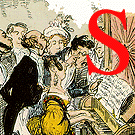
ome forty years later (and over thirty years after Cruikshank's death), with the centenary of the novelist's birth approaching, the rage for "extra illustrations from Dickens", unabated since the 1880s, resulted in such publishers as Raphael Tuck Character Sketches from Dickens providing wealthy connoisseurs with expensive, limited edition chromolithographs. Joseph Grego's reproducing Cruikshank's 1866 watercolours for the Oliver Twist illustrations as an art book must have been very expensive in 1911, and commanding a high price it would have had a limited appeal — but then only three hundred were printed. The coloured illustrations, based facsimile on those created by Cruikshank himself shortly after the conclusion of the novel's serial run, are not colourized wood- or steel-engravings like those in A Christmas Carol, but true chromolithographs, like Kyd's studies in two books of "extra" illustrations that he published in 1889 and 1892, and in the Player's cigarette card series of 1912.
The complete set of twenty-four working tracings of the original designs for "Oliver Twist," some of which exhibit variations from the finished etchings, realised £140 at Sotheby's in March 1892. Water-colour replicas of all the subjects were prepared by Cruikshank in 1866 for Mr. F. W. Cosens, which the artist supplemented by thirteen smaller drawings and a humorous title-page, the entire series being reproduced in colour for an edition de luxeof "Oliver Twist," published by Chapman & Hall in 1894. [Kitton 14]
In the preface to the 1911 collector's edition of Cruikshank's water-colours for two novels and an historical commentary, art historian Joseph Grego notes that Cruikshank rarely produced water-colours, preferring to illustrate books with "dainty pencil sketches, occasional finished in pen and ink" (xi).

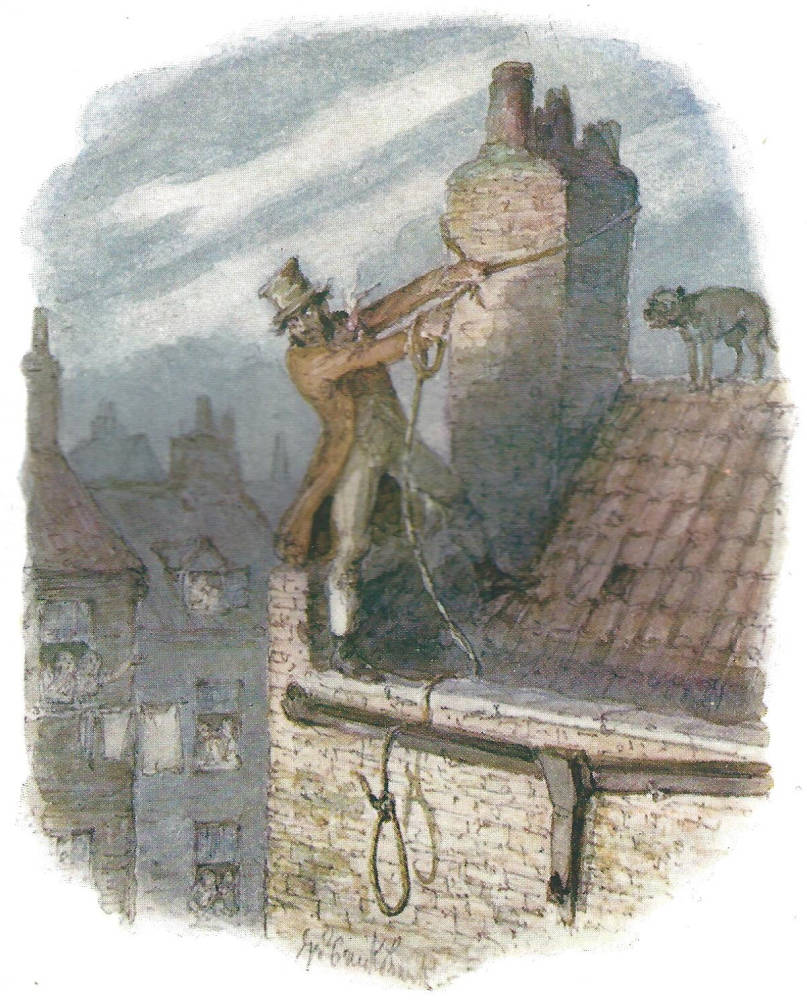
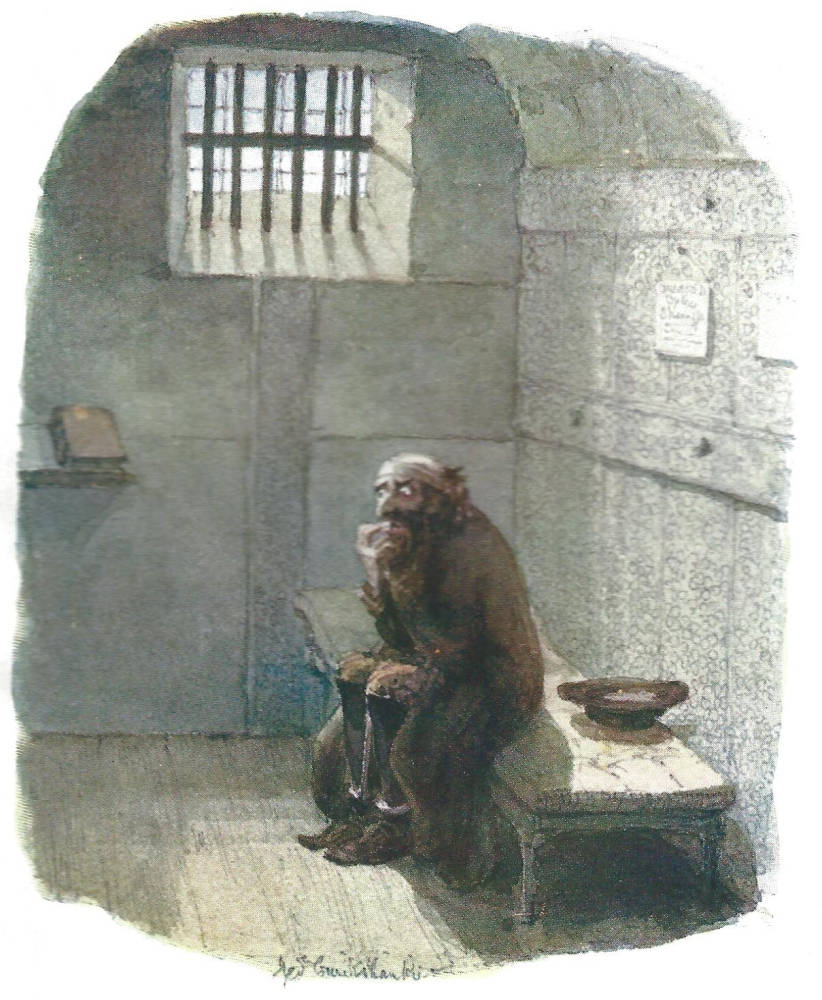
Left: Mr. Bumble degraded in the eyes of the Paupers. Middle: The Last Chance. Right: Fagin in the condemned Cell. Click on images to enlarge them.
For collectors prepared to pay a premium, Cruikshank did occasionally turn out hand-tinted "finished water-colour" drawings from such series as William Harrison Ainsworth's Tower of London and Windsor Castle. However, the bulk of his work is in black-and-white steel-engravings:
Cruikshank was a most dexterous artist in this monochrome branch, his earlier artistic experiences having been almost exclusively in the walk of aquatinted etchings; all his early book illustrations, his caricatures, and satirical plates — social or political — were uniformly etched by his hand in the most spirited fashion, after hi ready sketches and rough studies, and when the outline etching was bitten in, Cruikshank elaborately worked out his colour suggestions, for dark and light shade, with a brush over the first-etched outline, in tones of sepia or India ink, for the guidance of the professional 'aquatinters' — the school of artists to whose trained skill was entrusted the task of completing these plates to produce the effect of highly finished washed drawings in monochrome. [xii]
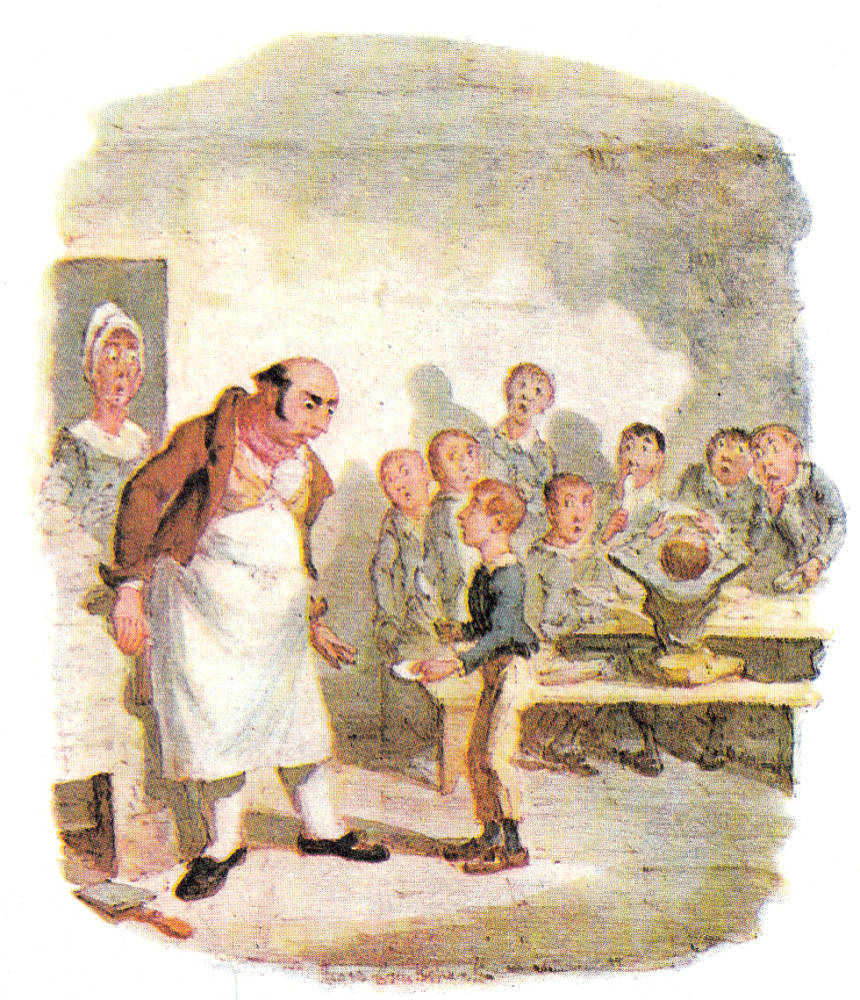
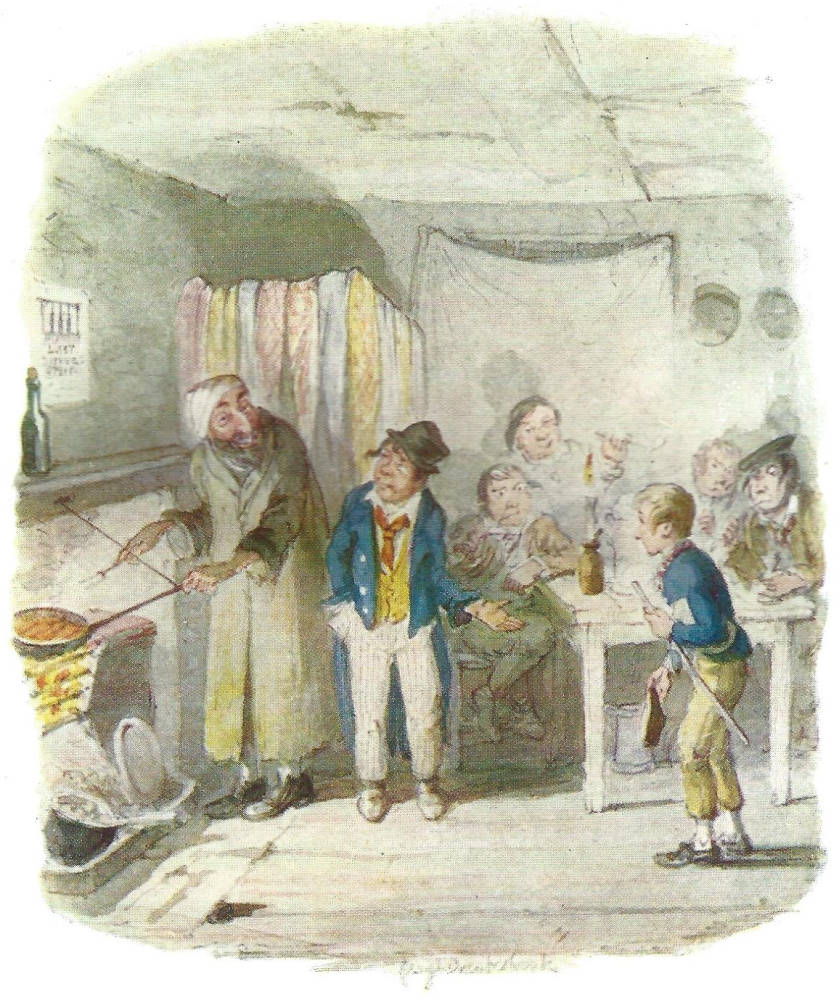
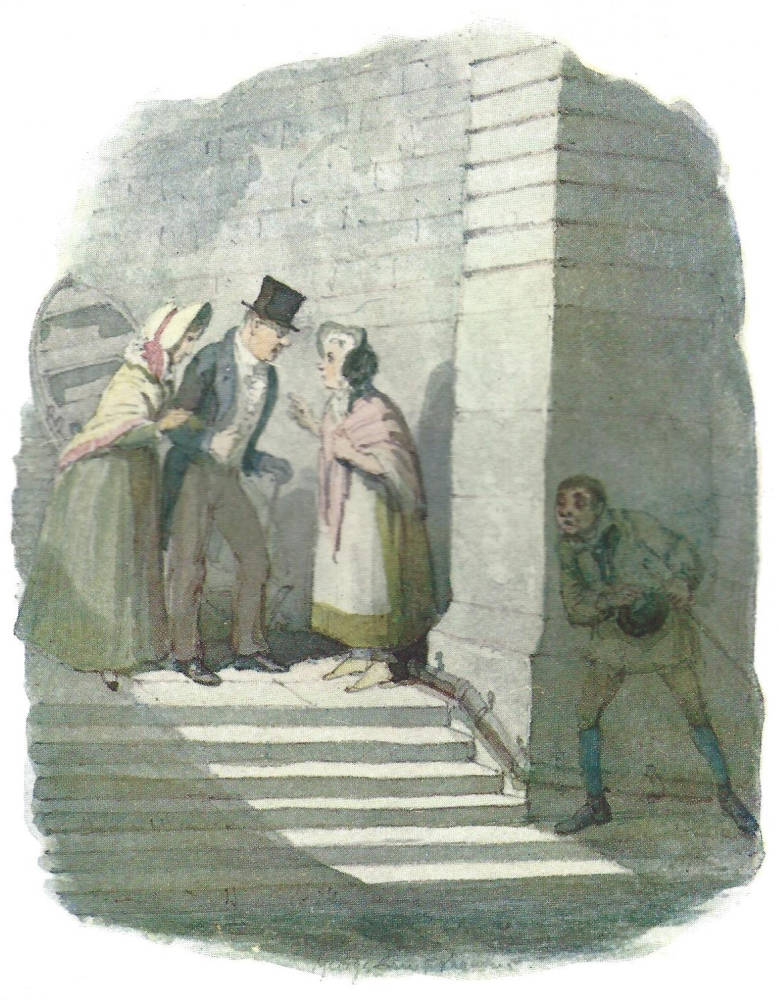
Left: Oliver Asking for More. Middle: Oliver introduced to the respectable Old Gentleman. Right: The Meeting. Click on images to enlarge them.
Initially Grego does not directly allude to the controversy over who was the actual originator of the characters and plots of Dickens's Oliver Twist and Ainsworth's The Miser's Daughter, but lauds Cruikshank's work as "pictorially unfolding" the progress of the parish boy in the "realistic romance" of the "great literary genius" of Charles Dickens, implying thereby that author and illustrator are co-presenters of the story, and by implication co-originators. However, subsequently he describes Cruikshank's claim for "fuller recognition, to the point of feeling it a deep personal grievance that the respective 'gifted authors' had wilfully adopted all his best ideas, without the formality of acknowledging their literary obligations and indebtedness to the artist himself" (xiv). Grego suggests that Cruikshank's Hogarthian conceptions were his own and admirably complemented the textual notions of his literary "collaborateurs," Dickens and Ainsworth, and that the illustrations in both instances are indicative of Cruikshank's own artistic genius — "confessedly the evidences of the drawings completely justify his not unreasonable contention" (xiv). Grego seems to accept unreservedly Cruikshank's contention that he designed the entire suite of Oliver drawings prior to Dickens's composing the serial instalments, despite the fact that one finds quite the opposite view of the novel's creation in the Cruikshank-Dickens correspondence in the Pilgrim Edition of the Letters of Charles Dickens, volume one. Grego goes so far as to quote a portion of Cruikshank's letter to The Times that describes how Cruikshank supposedly invited Dickens to his own home to enact ("described and performed") for the young writer the character of 'Fagin' "for Mr. Dickens to introduce into the work as a 'receiver of stolen goods'" (xx).
The text of the novel Oliver Twist follows, but, instead of Dickens's numbering and chapter titles, Grego presents the chapters with the titles of Cruikshank's illustrations, thereby reinforcing the notion that Cruikshank was the originator of the storyline. Cruikshank shows both the "fireside" or "cancelled" and "church" plates as numbers 26 and 27, significantly putting his original illustration ahead of the one that Dickens insisted he create: No. 26 is Oliver Twist with the Maylie family, facing p. 102; No. 27 The memorial tablet to Agnes, facing page 104. Plate captions correspond to those of the 1846 edition, except for the following pictures corresponding to the original series in Bentley's Miscellany and the volume editions of 1838 and 1846:
3. Oliver asking for more! facing p. 4 [original, 1846: Oliver's asking for more]
4. Oliver escapes being bound apprentice to a sweep, facing p. 6 [original, 1846: Oliver escapes being bound to a sweep, 16]
5. Oliver Twist introduced to the respectable old gentlemen, facing p. 16 [original, 1846: Oliver introduced to a respectable old gentleman, 43]
15. Oliver Twist found wounded at Mrs. Maylie's door, facing p. 50 [originial: Oliver at Mrs. Maylie's door, 156]
16. Oliver waited upon by the Bow Street runners, facing p. 54 [original: Oliver waited on by Bow Street runners, 171]
17. Reappearance of Monks and the Jew, facing p. 58 [original: Monks and the Jew, 192] [vii to viii]
22. The meeting at London Bridge, facing p. 82 [original: The Meeting, 261]
26. Oliver Twist with the Maylie family, 102 [not in more than a few of the original 1838 three-volume edition, and not in the periodical.]
27. The memorial tablet to Agnes, facing p. 104 [original: Rose Maylie and Oliver, 310].
The dimensions of the watercolours and the original steel-engraved plates are roughly the same (11.5 by 9.5 cm), but the pages on which the illustrations occur are not: 21.1 by 13.3 cm (1846 book) versus 26.5 by 20.7 cm (1903 book). Occasionally differences between corresponding plates are evident, as, for example, in the final plate, in which Rose's head is entirely set off by white space in the watercolour rather than against the shadow of the pillar in the country church.
Related material
- Extra Illustrations and Grangerising: A Dickensian Phenomenon
- The troubled relationship of Dickens and Cruishank
References
Bentley, Nicolas, Michael Slater, and Nina Burgis. The Dickens Index. New York and Oxford: Oxford U. P., 1990.
Cohen, Jane Rabb. Charles Dickens and His Original Illustrators. Columbus: Ohio State U. P., 1980.
Darley, Felix Octavius Carr. Character Sketches from Dickens. Philadelphia: Porter and Coates, 1888.
Davis, Paul. Charles Dickens A to Z: The Essential Reference to His Life and Work. New York: Facts On File, 1998.
Dickens, Charles. The Adventures of Oliver Twist; or, The Parish Boy's Progress. Illustrated by George Cruikshank. London: Chapman and Hall, 1846.
Grego, Joseph (intro). Cruikshank's Water Colours. [27Oliver Twist illustrations, including the wrapper and the 13-vignette title-page produced for F. W. Cosens; 20 plates for William Harrison Ainsworth's The Miser's Daughter: A Tale of the Year 1774; 20 plates plus the proofcover the work for W. H. Maxwell's History of the Irish Rebellion in 1798 and Emmetts Insurrection in 1803]. London: A & C Black, 1903. OT = pp. 1-106]. Book in the Rare Book Collection of the University of Toronto.
Hammerton, J. A. The Dickens Picture Book: A Record of the Dickens Illustrators. The Charles Dickens Library. Illustrated by Harry Furniss. London: Educational Book, 1910. Vol. 17.
Kitton, Frederic G. Dickens and His Illustrators. (1899). Rpt. Honolulu: university of Hawaii, 2004.
Patten, Robert L. Charles Dickens and His Publishers. Santa Cruz, Cal.: The Dickens Project, 1991; a rpt.. of the Oxford University Press edition of 1978.